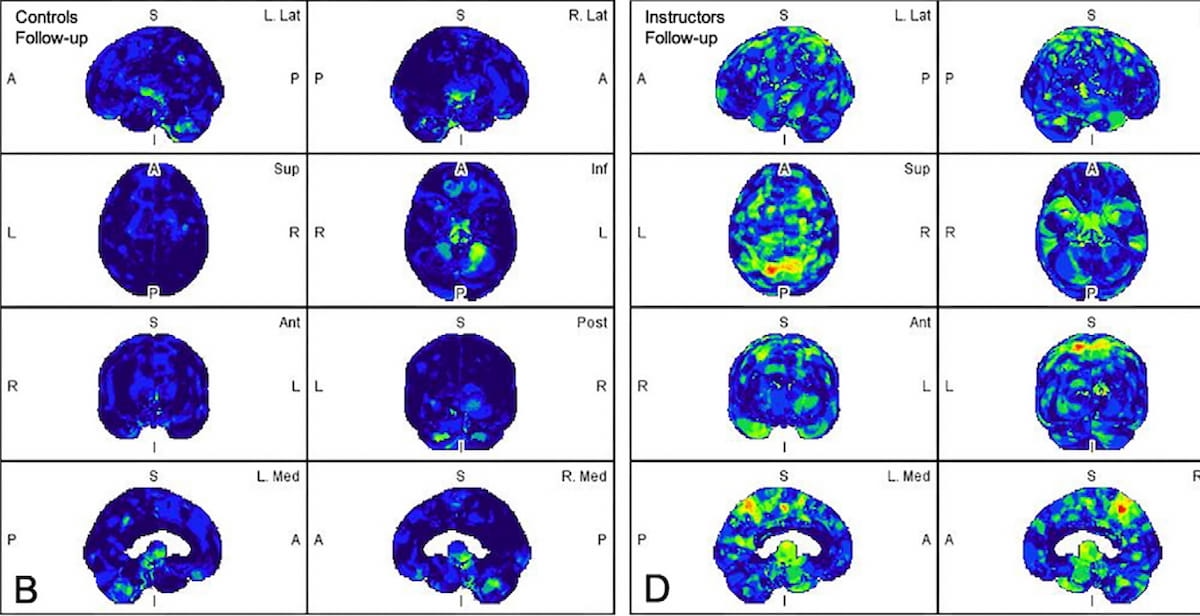Brain PET Study Suggests Link Between Early Amyloid Accumulation and Repetitive Subconcussive Trauma
After five months of exposure to repeated blast events, the majority of nine otherwise healthy military instructors had significantly increased amyloid deposition in the brain, according to positron emission tomography (PET) findings from a new study.
Emerging research with brain positron emission tomography (PET) imaging suggests a link between repetitive subconcussive trauma and increased amyloid deposition in the brain for otherwise healthy men.
For the study, recently published in Radiology, researchers utilized brain PET imaging to assess the impact of exposure to repeated blast events for nine military instructors (mean age of 33) and compared them to nine age-matched healthy controls.
Five months after military instructor exposure to repeated blast events, the study authors noted significantly increased amyloid deposition in the superior parietal lobule, precuneus, anterior cingulum and the inferomedial frontal lobe within this cohort. Out of the nine military instructors, three men had increased amyloid uptake in one brain region, two men had abnormal amyloid deposition in two brain regions and one study participant had abnormal amyloid increases in three regions of the brain, according to the study.
Noting that amyloid accumulation is a pathologic marker for Alzheimer’s disease (AD), the researchers pointed out that the amyloid increases seen on PET imaging were in brain regions known for abnormalities related to AD.
“(Traumatic brain injury) is a risk factor for the development of AD-type dementia or encephalopathy. Several autopsy studies have shown amyloid plaques to be present in the brain as early as hours after the injury, persisting years later,” wrote lead study author Carlos Leiva-Salinas, M.D., Ph.D., M.B.A., the chief of neuroradiology and director of the neuroradiology fellowship program at the University of Missouri School of Medicine, and colleagues.
Images courtesy of Radiology.

The researchers also noted that their use of a voxel-based approach to whole brain parametric mapping with PET may facilitate improved recognition of patterns associated with abnormal amyloid increases resulting from traumatic brain injury and set the table for future research endeavors.
“Because amyloid (beta) might accumulate in pre-symptomatic individuals years before symptoms of neurodegeneration manifest, understanding the relationship between traumatic injury and accumulation of amyloid (beta) might provide strategies to clear amyloid deposits. This ability may delay or even prevent neurodegeneration in both military and civilian populations,” suggested Leiva-Salinas and colleagues.
(Editor’s note: For related content, see “Can the Keto Diet Affect PET Imaging of the Brain?” and “Researcher Presents First Non-Invasive Images of Alpha-Synuclein in the Brain.”)
In an accompanying editorial, Sven Haller, M.D., MSc., noted that the study design’s emphasis on longitudinal assessment of the same study participants with repeat brain PET may have contributed to the early-stage detection of abnormal amyloid deposition that was not evident in prior studies.
“There is considerable interindividual variability in amyloid PET accumulation. Therefore, when comparing an individual case to a reference data set or when averaging individuals in a cross-sectional group analysis, subtle changes might remain hidden in the normal variation. However, the implemented intraindividual longitudinal design of this study avoids this interindividual variability and could detect subtle individual amyloid PET accumulation over time,” noted Dr. Haller, a neuroradiologist and medical director at the Centre d’Imagerie Medicale de Cornavin in Geneva, Switzerland.
In regard to study limitations, the authors acknowledged that the small sample size may have thwarted possible insights on associations between trauma burden and the degree of amyloid (beta) deposition. Leiva-Salinas and colleagues also noted that multiple follow-up points as opposed to the one five-month follow-up assessment in the study may have provided perspective on the evolution of the increased amyloid deposition. The absence of electronic telemetry equipment prevented assessment of blast severity upon amyloid deposition, according to the study authors.
Expanded FDA Approval Allows Use of Pluvicto Prior to Chemotherapy in Patients with mCRPC
March 28th 2025Recent research demonstrated a 59 percent reduced risk of progression or death with the radioligand therapy Pluvicto in comparison to a change of androgen receptor pathway inhibitor (ARPI) for patients with metastatic castration-resistant prostate cancer (mCRPC).
The Reading Room Podcast: Current Perspectives on the Updated Appropriate Use Criteria for Brain PET
March 18th 2025In a new podcast, Satoshi Minoshima, M.D., Ph.D., and James Williams, Ph.D., share their insights on the recently updated appropriate use criteria for amyloid PET and tau PET in patients with mild cognitive impairment.
Can CT-Based AI Help Predict Renal Function Decline After Radioligand Therapy for mCRPC?
February 25th 2025In patients who had at least four cycles of 177Lu-PSMA-I&T for mCRPC, new research shows that a 10 percent or greater decrease in total kidney volume on CT at six months has a 90 percent AUC for predicting estimated glomerular filtration rates (eGFRs) of 30 percent or greater at one year.